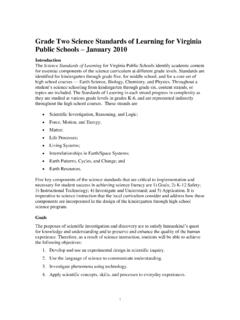Transcription of Magnetic Properties of Materials - University of Oxford
1 Magnetic Properties of Materials 1. Magnetisation of Materials due to a set of isolated atoms (or ions). a) Diamagnetism - Magnetic moment of filled shells of atoms. Induced moment opposes applied field b) Paramagnetism - unfilled shells have a finite Magnetic moment (orbital angular momentum) which aligns along the Magnetic field direction. 2. Collective magnetisation - Magnetic moments of adjacent atoms interact with each other to create a spontaneous alignment - Ferromagnetism, Ferrimagnetism, Antiferromagnetism Some useful background Definition of the fields: B is the Magnetic flux density (units Tesla). H is the Magnetic field strength (units Am-1). M is the magnetisation (the Magnetic dipole moment per unit volume, units Am-1).
2 B = 0 (H + M) = 0 r H = 0 H (1 + ). Relative susceptibility All Materials permeability linear Materials only M. when non linear in field =. H H 0. magnetism HT10 - RJ Nicholas 1. Magnetic Energy Energy in Magnetic Field = = 0 (H + M).H. = 0 H2 + Energy of a Magnetic moment m in Magnetic flux energy to align one dipole = - = -mzBz Energy density due to magnetisation of a material: E = Magnetic moment from a current loop: dm mi = I v dS = IA. = IdS. Magnetic Flux density B is: Nm i B = 0 H + 0 = 0 ( H + M ). V. M is Magnetic dipole moment /unit volume magnetism HT10 - RJ Nicholas 2. Langevin Diamagnetism Electrons in an atom precess in a eB. Magnetic field at the Larmor frequency: =.
3 2m Act as a current loop which shields the applied field 1 eB . I = charge/revolutions per unit time = ( Ze) . 2 2m . Area of loop = < 2> = (<x2> + <y2>) = 2/3 <r2>. Ze 2 B 2. Hence Magnetic moment induced/atom mi = r 6m For N atoms susceptibility Nm NZe 2 2. = 0 i = 0 r (per unit vol or per mole) B 6m Magnetic Levitation - An example of Magnetic energy density Energy due to magnetisation = Magnetic moment = V B/ 0 so force = -mdB/dx = - V (B dB/dx)/ 0 = - B2 V / 0. force = gradient of Field energy density B2 V . Levitation occurs when force balances gravitational force = V g, therefore: - B2 = g 0 / . Typical values of are of order 10-5 - 10-6. magnetism HT10 - RJ Nicholas 3.
4 Paramagnetism Unfilled shells. Magnetic moment of an atom or ion is: = -g BJ, where =J is the total angular momentum J=L+S and B is the Bohr magneton (e =/2m). A Magnetic field along z axis splits energy levels so: U = - .B = mJ g BB. mJ runs from J to -J. Spin system N ions with mJ = , g = 2, then U = BB, ratio of populations is given by Boltzman factor so we can write: N1 exp( B B ). = kT. N exp( B B ) + exp( B B ). kT kT. B. N2 exp( B ). = kT. N B ) + exp( B B ). exp( B. kT kT. Upper state N2 has moment - B , so writing x = BB/kT. e x e x M = ( N1 N 2 ) B = N B x = N B tanh x e + e x magnetism HT10 - RJ Nicholas 4. Magnetisation Magnetisation saturates at high fields and low temperatures B.
5 M = N B tanh B. k BT. Low field, higher temperature limit tanh x x M N 0 B2. Curie's Law: = =. H k BT. Compare with 3N 0 B2. =. Pauli paramagnetism 2k BTF. General Result for mJ J -J. 2J + 1 2J + 1 . M = NgJ B ( ) coth( ) y ( 1 ) coth( 1 ) y . 2J 2J 2J 2J . Curie's Law J + 1 gJ B B. as y 0, M = NgJ B. 3J kT. M J ( J + 1) g 2 B 2 C. = = 0 N =. H 3kT T. as y , M sat = Ng B J. magnetism HT10 - RJ Nicholas 5. Saturation behaviour Curie Law at low field Saturation at high field Magnetic Resonance Energy Apply a Magnetic field to split up energy levels and observe transitions between them Magnetic Field For a simple spin system = = g BB - selection rule is mJ.
6 = 1 (conservation of angular momentum). When ions interact with the crystal environment or each other then extra splittings can occur. magnetism HT10 - RJ Nicholas 6. Magnetic Resonance Experiment Experiment uses microwaves (10 - 100 GHz), with waveguides and resonant cavities Resonance Spectrum Relate to Crystal field splittings magnetism HT10 - RJ Nicholas 7. Nuclear Magnetic Resonance Similar to spin resonance of electrons, but from spin of nuclei. Energy is smaller due to the much smaller value of BN. Resonance condition is = = g N(B + B). B is the chemical shift due to Magnetic flux from orbital motion of electrons in the atom. 0m Ze 2 B 2 0. B = = r.
7 3. r3 6m r Diamagnetic Magnetic moment induced in a single atom and Chemical sensitivity is used in Scan Magnetic field with a monitoring many field gradient in order to biochemical and biological achieve chemically processes sensitive imaging NMR MRI. magnetism HT10 - RJ Nicholas 8. Magnetic Cooling (adiabatic demagnetisation). Cool a solid containing alot of Magnetic ions in a Magnetic field. Energy levels are split by U = BBi Population ratio is N+ 2 B . = exp B i . N kTi . Remove Magnetic field quickly while keeping population of spins the same - Adiabatically kT f kTi Tf is limited by small interactions = between ions which split energy B B f B Bi levels at B = 0.
8 Interactions between Magnetic ions Dipole - dipole interactions Neighbouring atoms exert a force on each other which tries to align dipoles m. Interaction energy is U = Magnetic flux B is 0(m/4 r3 - 3( )r/4 r5) so U = ~ - 0 r3 = - 0 B2/4 r3. r is separation of atoms (approx. ) giving U = 4 x 10-25 J = K. If all atomic dipoles are aligned the magnetisation is: M = N B giving a total Magnetic flux B = 0 N B ~ 1T. so: U = x 10-23 J ~ K. magnetism HT10 - RJ Nicholas 9. Collective magnetism - Ferro-, Antiferro- and Ferrimagnetism Oldest piece of Condensed Matter physics known about and exploited is ferromagnetism. Why do spins align at temperatures as high as 1000 K ?
9 ? It is definitely not due to Magnetic dipole-dipole interactions. The strong interaction is due to the action of the Pauli exclusion principle which produces: Exchange Interactions Exchange Interaction Consider two adjacent atoms and two electrons with a total wavefunction (r1,r2;s1,s2). Pauli exclusion principle: (r1,r2;s1,s2) = - (r2,r1;s2,s1). If r1 = r2 and s1 = s2 then = 0. Electrons with same spin repel' each other and form symmetric and antisymmetric wavefunctions [ a(r1) = 3d(r1-ra)]. s (1,2) = [ a(r1) b(r2) + a(r2) b(r1)] s( ). t (1,2) = [ a(r1) b(r2) - a(r2) b(r1)] t( ). Energy difference between singlet and triplet is dependent on alignment of the spins U = magnetism HT10 - RJ Nicholas 10.
10 Energy difference given by the exchange integral'. e2 2e 2 *. J = 2 a (1) b (1) . *. a (2) b (2)d r1d r2. 3 3. 4 0 r12 4 0 r1 . Positive term Negative term electron-electron electron-ion coupling coupling Comes from electrostatic (Coulomb) interactions J>0 J<0. Electron spins align Electron spins antiparallel Ferromagnetic coupling Anti-ferromagnets Covalent bonding Molecular Field Model Energy of one spin in an external Magnetic flux B0. U = S i . J ijS j + g B B0 .S i = J ij S i . S j + g B B0 .S i which can be considered as due to an effective flux Beff Beff = B0 + 0 M , 2 J ij j i where M = Ng B S and =. N 0 g 2 B2. Spins are aligned by the combination of the external flux B and the internal magnetisation.





